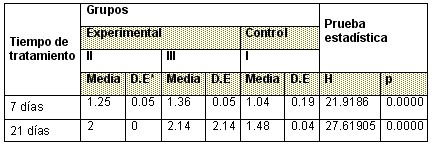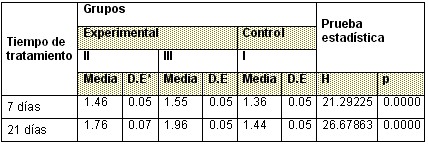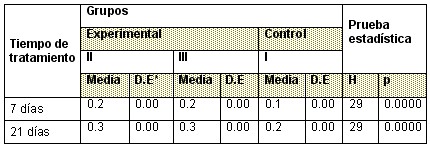Efecto del suplemento del Sulfato de Zinc en el desarrollo oseo en ratas con Crecimiento Intrauterin
Tabla 3: Comportamiento del diámetro anteroposterior

Tabla 4: Comportamiento del diámetro biparietal
En relación con los diámetros craneanos anteroposterior y biparietal el estudio evidenció diferencias estadisticamente significativas entre el grupo control y los grupos experimentales, si tenemos en cuenta el valor de la media y el valor del estadigrafo de prueba. (Tablas 3 y 4)

Tabla 5: Comportamiento de la longitud media de Mandíbula

Con respecto a la longitud media de la Mandíbula, el comportamiento es similar a los anteriores, los grupos experimentales mostraron valores superiores a los del grupo control, con un nivel de significancia igual a los anteriores.(Tabla 5)
Tabla 6: Comportamiento del Ancho del Hueso

El Ancho del Hueso se comportó de igual manera que las medidas de los huesos largos y los diámetros craneanos donde se encontraron diferencias en los tres grupos con respecto a los valores de la media y el valor del estadígrafo el cual resulta significativo. (Tabla 6)
Conclusiones:
1- Existe efecto favorable al crecimiento óseo en las ratas nacidas con crecimiento intrauterino retardado, a las que se le administro Sulfato de Zinc.
2- El crecimiento óseo fue mayor en las crías que se les administró una dosis de Sulfato de Zinc de 10mg/kg/día y a las que se les prolongo el tratamiento por un período de 21 días.
Bibliografia consultada:
1 Wiglesworth, J. S (1964). Experimental Growth retardation in the fetal rat J. Pathol. And Bacteriology. 88 (1): 1-13.
2 Hoohenauer, L and W. Oh (1969) Body Composition in experimental growth retardation in the rat. J. Nutr. 99:23-26.
3 Chung-Ja, M. et al (1987). Growth and cellular composition in the rat with intrauterine growth retardation: Effect of postnatal nutrition. J. Nutr.117:1463-1468.
4 Nitzan , M., S. Orloff and J. Schullman (1979). Placental transfer of analogs of glucose and amino acid in experimental intrauterine growth retardation. Ped. Res. 13:100-103.
5 Hayashi, T.T. and M. E. Dolks (1988). A rat model for the study of intrauterine growth retardation. Am, J. Obstetric Gynecol 158: 1203-1207.
6 Arias G, Torres MR, Pérez N, Milián M. Factores prenatales relacionados con la prematuridad. Rev. Cub. Pediatría 2001; 73: 11-5.
7 Peraza G, Pérez SC, Figueroa ZA. Factores asociados al bajo peso al nacer. Rev. Cub. Med. Gen. Integr. 2001; 17: 490- 6.
8 Castro M, Sánchez IL, Medina C, Padrón R. Evolución del niño con bajo peso al nacer en su primer año de vida. MEDISAN 2000; 4: 20-26.
9 Peraza G, Gil JY, Arce A, Gil J. Factores de riesgo en el bajo peso al nacer. Rev Cub Med Gen Integr 2000; 16: 68-72.
10 Chaviano J, López D. Edad materna, riesgo nutricional preconcepcional y peso al nacer. Rev Cub Aliment Nutr 2000; 14: 949.
11 Goldenberg RL, Cliver SP. Small for gestational age and intrauterine growth restriction: Definitions and standards. Clin Obste. Gynecol 1997 ; 40: 704-14.
12 Fernandez-Twinn DS, Ozanne SE, Ekizoglou S, Doherty C, James L, Gusterson B, Hales CN. The maternal endocrine environment in the low-protein model of intra-uterine growth restriction. Br J Nutr 2003; 90: 815-22.
13 Longo ID. Hypoxia-ischaemia and the developing brain: hypothesis regarding the path physiology of fetal-neonatal brain damage. J Obstet Gynaecol 1997; 104: 652–662.
14 Schwartz JE, Kovach A, Meyer J, McConnell C. Brief, intermittent hypoxia restricts fetal growth in Sprague- Dawley rats. Biol Neonate 1998; 73: 313-319.
15 Peraza G, Pérez SC, Figueroa ZA. Factores asociados al bajo peso al nacer. Rev. Cub. Med Gen Integr 2001; 17: 490-6.
16 Álvarez R, Urra LR, Aliño M. Repercusión de los factores de riesgo en el bajo peso al nacer. RESUMED 2001; 14: 115-21.
17 Robinson JS, Moore VM, Owens JA, McMillen IC. Origins of fetal growth restriction. Eur Obstet Gynecol Reprod Biol 2000; 92(1): 13-9.
18 Sibbley CP, Nelson DM, Powell T. Mechanisms of materno fetal exchange across the human placenta. Biochem Soc Trans 1998; 26: 86–90.
19 Pardi GA, Marconi AM, Cetin I. Placental-fetal Interrelationship in IUGR Fetuses. Placenta 2002; 23 (1): 136-141.
20 Hafner E, Metzenbauer M, Dillinger-Paller B, Hoefinger D, Schuchter K, Sommer-Wagner K, Philipp K. Correlation of first trimester placental volume and second trimester uterine artery Doppler flow. Placenta 2001; 22: 729–734.
21 Dashe JS, McIntire D, Lucas MJ, Leveno KJ. Effects of symmetric and asymmetric fetal growth on pregnancy outcomes.
Obstet Gynecol 2000; 96(3): 321-7.
22 Bauer RB, Walter B, Gaser E, Rosel T, Kluge H, Zwiener U. Cardiovascular function and brain metabolites in normal weight and intrauterine growth restricted newborn piglets--effect of mild hypoxia. Exp Toxicol Pathol 1998; 50(4-6): 294-300.
23 Tomé O, Alfonso C. Comportamiento postnatal de variables somatométricas en crías de rata con crecimiento intrauterino retardado experimental. Rev Cub Cienc Vet 2001; 27(1): 15-17.
24 Morales-Rosello J. Physiologic restriction versus genetic weight potential: Study in normal fetuses and in fetuses with intrauterine growth retardation. J Ultrasound Med 1999; May; 18: 343.
25 Haggard C, Bauer MK. Rodent model of intrauterine growth restriction. Scand J Lab Anim Sci 2001; 28 (1).
26 Peleg D, M. Kennedy C, Hunter SK. Intrauterine growth restriction: Identification and management. Am J Obstetric Gynecol 1998; 159: 1303-1308.
27 Luo R, Mao M, Xiao X. Level of nerve growth factor protein in cerebellar cortex of rat pups in intrauterine growth retardation model by clamping the uterine vasculature of pregnant rat. Hua Xi Yi Ke Da Xue Bao 2001; Mar; 32(1): 89-91
28 Pan SL, Yu YH . Establishment of a new rat model of intrauterine growth retardation. Di Yi Jun Yi Da Xue Bao 2002; Apr; 22(4): 339-43.
29 Peterside I, Selak EM, Simmons RA. Impaired oxidative phosphorylation in hepatic mitochondria in growth-retarded rat. Am J Physiol Endocrinol Metab 2003; Dec; 285(6): E1258-66.
30 Cruz MA. Estudio morfológico del intestino delgado en ratas con crecimiento intrauterino retardado. Instituto Superior de Ciencias Médicas de la Habana. (Tesis para optar por el título de especialista de primer grado en Embriología); La Habana. 1991.
31 Gordon PV, Marshal D, Stiles AD, Price WA. The clinical, morphologic and molecular changes in the ileum associated with early postnatal dexamethasone administration: from the baby's bowel to the researcher's bench. Mol Genet Metab 2001; Feb; 72(2): 91-103.
32 Pham TD, MacLennan NK, Chiu CT, Laksana GS, Hsu JL, Lane R. Uteroplacental insufficiency increases apoptosis and alters p53 gene methylation in the full-term IUGR rat kidney. Am J Physiol Regul Integr Comp Physiol 2003; Nov; 285(5): R933-4.
33 Bauer R, Walter R, Bauer K, Klupsch R, Pattf S, Zwiener U. Intrauterine growth restriction reduces nephron number and renal excretory function in newborn. Acta Physiologica Scandinavica 2002; 176 (2): 83.
34 Jackson JA, Wailoo MP, Peterson SA. Early physiological development of infants with intrauterine growth retardation. Arch Dis Child Fetal Neonatal 2004; 89: 46-50.
35. Sallout B, Walker M. The fetal origin of adults diseases. J Obstet Gynecol 2003; 23: 555-60.
Autores:
1- Dra. Beatriz de la C Mazón González
Especialista de Primer Grado en Embriología. Especialista de Primer Grado en Medicina General Integral. Profesor Instructor. Instituto Superior de Ciencias Médicas de la Habana.
2- Dr. Marco J. Albert Cabrera
Máster en Ciencias. Especialista de Primer y Segundo Grados de Medicina Interna. Especialista de Segundo Grado de Medicina General Integral Profesor Auxiliar. Instituto Superior de Ciencias Médicas de la Habana.